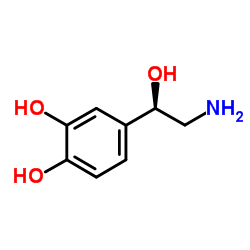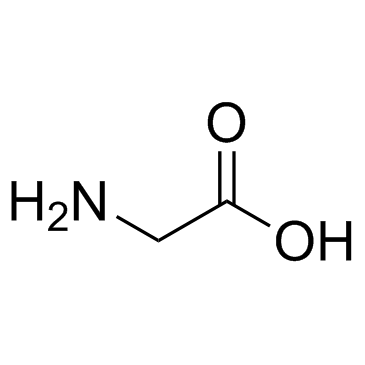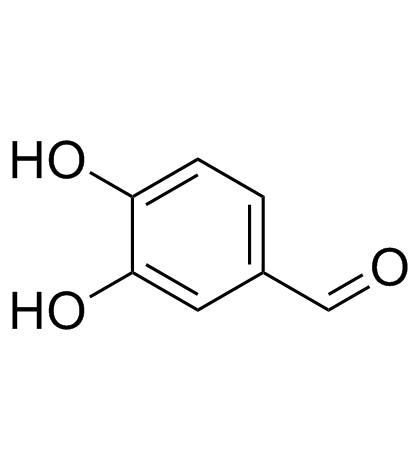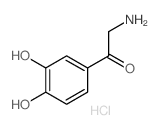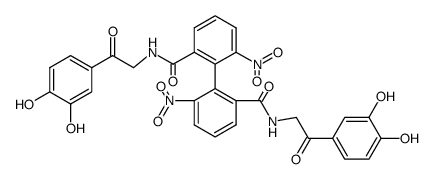51-41-2
| 中文名 | 去甲肾上腺素 |
|---|---|
| 英文名 | (R)-noradrenaline |
| 中文别名 | (R)-4-(2-氨基-1-羟基乙基)-1,2-苯二酚 |
| 英文别名 |
(−)-Norepinephrine
(-)-NORADRENALINE 1,2-Benzenediol, 4-(2-amino-1-hydroxyethyl)-, (R)-(-)- 4-[(1R)-2-amino-1-hydroxyéthyl]benzène-1,2-diol L-NOREPINEPHRINE 4-((R)-2-Amino-1-hydroxy-ethyl)-benzene-1,2-diol 1,2-Benzenediol, 4-[(1R)-2-amino-1-hydroxyethyl]- EINECS 205-750-4 (R)-4-(2-amino-1-hydroxyethyl)-1,2-benzenediol norepinephrinum [INN_la] noradrenaline 1,2-Benzenediol, 4-((R)-2-amino-1-hydroxyethyl)- L-NORADRENALINE (R)-(-)-norepinephrine (-)-a-(Aminomethyl)protocatechuyl alcohol 4-[(1R)-2-Amino-1-hydroxyethyl]benzol-1,2-diol Noradrenalin (-)-norepinephrine (R)-4-(2-amino-1-hydroxyethyl)benzene-1,2-diol (R)-norepinephrine MFCD00025592 (R)-noradrenaline 4-[(1R)-2-Amino-1-hydroxyethyl]benzene-1,2-diol Norepinephrine (-)-(R)-Norepinephrine 1,2-Benzenediol, 4-(2-amino-1-hydroxyethyl)-, (R)- 4-[(1R)-2-Amino-1-hydroxyethyl]-1,2-benzenediol |
| 描述 | Norepinephrine是作用于α-肾上腺素能受体 (alpha-adrenergic receptors) 的外周血管收缩剂。 |
|---|---|
| 相关类别 | |
| 靶点 |
Human Endogenous Metabolite |
| 参考文献 |
| 密度 | 1.4±0.1 g/cm3 |
|---|---|
| 沸点 | 442.6±40.0 °C at 760 mmHg |
| 熔点 | 220-230°C |
| 分子式 | C8H11NO3 |
| 分子量 | 169.178 |
| 闪点 | 221.5±27.3 °C |
| 精确质量 | 169.073898 |
| PSA | 86.71000 |
| LogP | -0.88 |
| 外观性状 | 结晶 |
| 蒸汽压 | 0.0±1.1 mmHg at 25°C |
| 折射率 | 1.659 |
| 储存条件 | 充氩气密封于4℃避光保存。 |
| 稳定性 | Stable, but may be light-sensitive. Incompatible with acids, bases, oxidizing agents. Store at -20C. |
| 分子结构 | 1、 摩尔折射率:44.63 2、 摩尔体积(cm3/mol):121.0 3、 等张比容(90.2K):358.3 4、 表面张力(dyne/cm):76.7 5、 极化率(10-24cm3):17.69 |
| 计算化学 | 1.疏水参数计算参考值(XlogP):无 2.氢键供体数量:4 3.氢键受体数量:4 4.可旋转化学键数量:2 5.互变异构体数量:10 6.拓扑分子极性表面积86.7 7.重原子数量:12 8.表面电荷:0 9.复杂度:142 10.同位素原子数量:0 11.确定原子立构中心数量:1 12.不确定原子立构中心数量:0 13.确定化学键立构中心数量:0 14.不确定化学键立构中心数量:0 15.共价键单元数量:1 |
| 更多 | 1. 性状: 类白色至褐色细微结晶。对光和空气敏感。 2. 密度(g/mL,25/4℃): 未确定 3. 相对蒸汽密度(g/mL,空气=1):未确定 4. 熔点(ºC): 216.5~218℃(分解) 5. 沸点(ºC,常压):未确定 6. 沸点(ºC,5.2kPa):未确定 7. 折射率:未确定 8. 闪点(ºC):未确定 9. 比旋光度(º):[α]D25 -37.3°(C=5,1mol/L盐酸中) 10. 自燃点或引燃温度(ºC):未确定 11. 蒸气压(kPa,25ºC):未确定 12. 饱和蒸气压(kPa,60ºC):未确定 13. 燃烧热(KJ/mol):未确定 14. 临界温度(ºC):未确定 15. 临界压力(KPa):未确定 16. 油水(辛醇/水)分配系数的对数值:未确定 17. 爆炸上限(%,V/V):未确定 18. 爆炸下限(%,V/V):未确定 19. 溶解性:溶于无机酸和碱,微溶于水、甲醇、乙醇和乙醚。 |
|
Section 1. Chemical Product and Company Identification L-Norepinephrine Common Name/ Trade Name L-Norepinephrine Section 3. Hazards Identification Potential Acute Health Effects Very hazardous in case of ingestion. Slightly hazardous in case of skin contact (irritant), of eye contact (irritant),
of inhalation. Severe over-exposure can result in death. Potential Chronic Health EffectsCARCINOGENIC EFFECTS: Not available. MUTAGENIC EFFECTS: Mutagenic for bacteria and/or yeast. TERATOGENIC EFFECTS: Not available. DEVELOPMENTAL TOXICITY: Not available. The substance is toxic to cardiovascular system. The substance may be toxic to muscle tissue. Repeated or prolonged exposure to the substance can produce target organs damage. Repeated exposure to a highly toxic material may produce general deterioration of health by an accumulation in one or many human organs. Section 4. First Aid Measures Eye ContactCheck for and remove any contact lenses. In case of contact, immediately flush eyes with plenty of water for at least 15 minutes. Get medical attention if irritation occurs. Skin ContactWash with soap and water. Cover the irritated skin with an emollient. Get medical attention if irritation develops. Not available. Serious Skin Contact If inhaled, remove to fresh air. If not breathing, give artificial respiration. If breathing is difficult, give oxygen. Inhalation Get medical attention. Serious InhalationEvacuate the victim to a safe area as soon as possible. Loosen tight clothing such as a collar, tie, belt or waistband. If breathing is difficult, administer oxygen. If the victim is not breathing, perform mouth-to-mouth resuscitation. Seek medical attention. IngestionIf swallowed, do not induce vomiting unless directed to do so by medical personnel. Never give anything by mouth to an unconscious person. Loosen tight clothing such as a collar, tie, belt or waistband. Get medical attention immediately. Serious IngestionNot available. Section 5. Fire and Explosion Data Flammability of the ProductMay be combustible at high temperature. Not available. Auto-Ignition Temperature Not available. Flash Points Not available. Flammable Limits These products are carbon oxides (CO, CO2), nitrogen oxides (NO, NO2...). Products of Combustion Slightly flammable to flammable in presence of heat. Fire Hazards in Presence of Various Substances Explosion Hazards in Presence of Risks of explosion of the product in presence of mechanical impact: Not available. Various SubstancesRisks of explosion of the product in presence of static discharge: Not available. SMALL FIRE: Use DRY chemical powder. Fire Fighting Media LARGE FIRE: Use water spray, fog or foam. Do not use water jet. and Instructions As with most organic solids, fire is possible at elevated temperatures Special Remarks on Fire Hazards Fine dust dispersed in air in sufficient concentrations, and in the presence of an ignition source is a potential dust Special Remarks on Explosion explosion hazard. Hazards L-Norepinephrine Section 6. Accidental Release Measures Use appropriate tools to put the spilled solid in a convenient waste disposal container. Small Spill Poisonous solid. Large Spill Stop leak if without risk. Do not get water inside container. Do not touch spilled material. Use water spray to reduce vapors. Prevent entry into sewers, basements or confined areas; dike if needed. Eliminate all ignition Section 7. Handling and Storage Keep away from heat. Keep away from sources of ignition. Ground all equipment containing material. Do not Precautions ingest. Do not breathe dust. Wear suitable protective clothing. If ingested, seek medical advice immediately and show the container or the label. Keep away from incompatibles such as oxidizing agents, acids, alkalis. Keep container tightly closed. Keep container in a cool, well-ventilated area. Do not store above -20°C (-4°F). Storage Freeze. Section 8. Exposure Controls/Personal Protection Engineering ControlsUse process enclosures, local exhaust ventilation, or other engineering controls to keep airborne levels below recommended exposure limits. If user operations generate dust, fume or mist, use ventilation to keep exposure to airborne contaminants below the exposure limit. Personal ProtectionSafety glasses. Lab coat. Dust respirator. Be sure to use an approved/certified respirator or equivalent. Gloves. Personal Protection in Case of a Splash goggles. Full suit. Dust respirator. Boots. Gloves. A self contained breathing apparatus should be used Large Spillto avoid inhalation of the product. Suggested protective clothing might not be sufficient; consult a specialist BEFORE handling this product. Exposure LimitsNot available. Section 9. Physical and Chemical Properties Physical state and appearance Solid. (Crystalline solid. Crystalline powder.)Not available. Odor TasteNot available. Molecular Weight169.18 g/mole Off-white. Color Not available. pH (1% soln/water) Not available. Boiling Point Melting Point220°C (428°F) Critical TemperatureNot available. Not available. Specific Gravity Not applicable. Vapor Pressure Vapor DensityNot available. Not available. Volatility Not available. Odor Threshold Water/Oil Dist. Coeff.Not available. Ionicity (in Water)Not available. Not available. Dispersion Properties Not available. Solubility L-Norepinephrine Section 10. Stability and Reactivity Data The product is stable. Stability Instability TemperatureNot available. Conditions of InstabilityExcess heat, incompatible materials Reactive with oxidizing agents, acids, alkalis. Incompatibility with various substances Not available. Corrosivity Not available. Special Remarks on Reactivity Not available. Special Remarks on Corrosivity PolymerizationWill not occur. Section 11. Toxicological Information Routes of EntryInhalation. Ingestion. Toxicity to AnimalsAcute oral toxicity (LD50): 20 mg/kg [Mouse]. Chronic Effects on HumansMUTAGENIC EFFECTS: Mutagenic for bacteria and/or yeast. Causes damage to the following organs: cardiovascular system. May cause damage to the following organs: muscle tissue. Other Toxic Effects on Humans Very hazardous in case of ingestion. Slightly hazardous in case of skin contact (irritant), of inhalation. Special Remarks onNot available. Toxicity to Animals Human: passes the placental barrier. Special Remarks on May cause adverse reproductive effects and birth defects (teratogenic). Chronic Effects on Humans May affect genetic material (mutagenic) Acute Potential Health Effects: Special Remarks on other Toxic Skin: May cause skin irritation. Effects on Humans Eyes: May cause eye irritation. Inhalation: Dust may cause respiratory tract irritation. Ingestion: May be fatal if swallowed. May cause nausea, vomiting, and hypersalivation. Affects the cardiovascular system/heat (hypertension, dradycardia, arrhythmias, anginal pain, palpitations, cardiac arrest, sudden death. May affect metabolism (altered glucose metabolism). May affect the blood (aggregated pltelets and occlusive platelet thrombi), behavior/central nervous system (fear, anxiety, restlessness, tremor, insomnia, somnolence, muscle weakness, confusion, irritability, weakness, psychosis), kidneys (nephrotoxicity), respiration (dyspnea). Section 12. Ecological Information EcotoxicityNot available. BOD5 and CODNot available. Possibly hazardous short term degradation products are not likely. However, long term degradation products may Products of Biodegradation arise. The products of degradation are less toxic than the product itself. Toxicity of the Products of Biodegradation Not available. Special Remarks on the Products of Biodegradation L-Norepinephrine Section 13. Disposal Considerations Waste DisposalWaste must be disposed of in accordance with federal, state and local environmental control regulations. Section 14. Transport Information DOT ClassificationCLASS 6.1: Poisonous material. UNNA: 2811 : Toxic solid, organic, n.o.s(L-Norepinephrine) PG: II Identification Not available. Special Provisions for Transport DOT (Pictograms) Section 15. Other Regulatory Information and Pictograms Federal and StateNo products were found. Regulations CaliforniaCalifornia prop. 65: This product contains the following ingredients for which the State of California has found to cause cancer which would require a warning under the statute: No products were found. Proposition 65 Warnings California prop. 65: This product contains the following ingredients for which the State of California has found to cause birth defects which would require a warning under the statute: No products were found. OSHA: Hazardous by definition of Hazard Communication Standard (29 CFR 1910.1200). Other Regulations EINECS: This product is on the European Inventory of Existing Commercial Chemical Substances. CLASS D-1A: Material causing immediate and serious toxic effects (VERY TOXIC). Other ClassificationsWHMIS (Canada) DSCL (EEC)R28- Very toxic if swallowed.S28- After contact with skin, wash immediately with plenty of water S36/37- Wear suitable protective clothing and gloves. S45- In case of accident or if you feel unwell, seek medical advice immediately (show the label where possible). Health Hazard HMIS (U.S.A.)3 National Fire Protection 1 Flammability 1 Association (U.S.A.) Fire Hazard 3 0 Reactivity Health Reactivity 0 Specific hazard Personal Protection E WHMIS (Canada) (Pictograms) DSCL (Europe) (Pictograms) L-Norepinephrine TDG (Canada) (Pictograms) ADR (Europe) (Pictograms) Protective Equipment Gloves. Lab coat. Dust respirator. Be sure to use an approved/certified respirator or equivalent. Wear appropriate respirator when ventilation is inadequate. SECTION 16 - ADDITIONAL INFORMATION N/A |
CHEMICAL IDENTIFICATION
HEALTH HAZARD DATAACUTE TOXICITY DATA
MUTATION DATA
|
| 符号 |

GHS06 |
|---|---|
| 信号词 | Danger |
| 危害声明 | H300-H310-H330 |
| 警示性声明 | P260-P264-P280-P284-P302 + P350-P310 |
| 个人防护装备 | Eyeshields;Faceshields;full-face particle respirator type N100 (US);Gloves;respirator cartridge type N100 (US);type P1 (EN143) respirator filter;type P3 (EN 143) respirator cartridges |
| 危害码 (欧洲) | T+:Verytoxic; |
| 风险声明 (欧洲) | R26/27/28 |
| 安全声明 (欧洲) | S28-S36/37-S45 |
| 危险品运输编码 | UN 2811 6.1/PG 2 |
| WGK德国 | 3 |
| RTECS号 | DN5950000 |
| 包装等级 | II |
| 危险类别 | 6.1 |
| 海关编码 | 2922509090 |
|
~50% 
51-41-2 |
| 文献:Muller; Keil; Gerhard Tetrahedron, 1986 , vol. 42, # 5 p. 1529 - 1532 |
|
~% 
51-41-2 |
| 文献:Tullar Journal of the American Chemical Society, 1948 , vol. 70, p. 2067,2068 |
|
~% 
51-41-2 |
| 文献:Steinreiber, Johannes; Schuermann, Martin; Van Assema, Friso; Wolberg, Michael; Fesko, Kateryna; Reisinger, Christoph; Mink, Daniel; Griengl, Herfried Advanced Synthesis and Catalysis, 2007 , vol. 349, # 8-9 p. 1379 - 1386 |
|
~% 
51-41-2 |
| 文献:Muller; Keil; Gerhard Tetrahedron, 1986 , vol. 42, # 5 p. 1529 - 1532 |
|
~% 
51-41-2 |
| 文献:Muller; Keil; Gerhard Tetrahedron, 1986 , vol. 42, # 5 p. 1529 - 1532 |
| 上游产品 5 | |
|---|---|
| 下游产品 2 | |
| 海关编码 | 2922509090 |
|---|---|
| 中文概述 | 2922509090. 其他氨基醇酚、氨基酸酚及其他含氧基氨基化合物. 增值税率:17.0%. 退税率:13.0%. 监管条件:AB. 最惠国关税:6.5%. 普通关税:30.0% |
| 申报要素 | 品名, 成分含量, 用途, 乙醇胺及其盐应报明色度, 乙醇胺及其盐应报明包装 |
| 监管条件 | A.入境货物通关单 B.出境货物通关单 |
| 检验检疫 | R.进口食品卫生监督检验 S.出口食品卫生监督检验 |
| Summary | 2922509090. other amino-alcohol-phenols, amino-acid-phenols and other amino-compounds with oxygen function. VAT:17.0%. Tax rebate rate:13.0%. . MFN tariff:6.5%. General tariff:30.0% |



